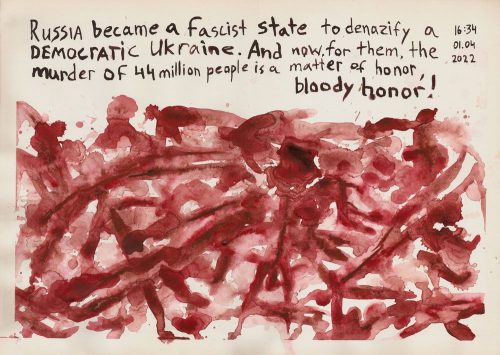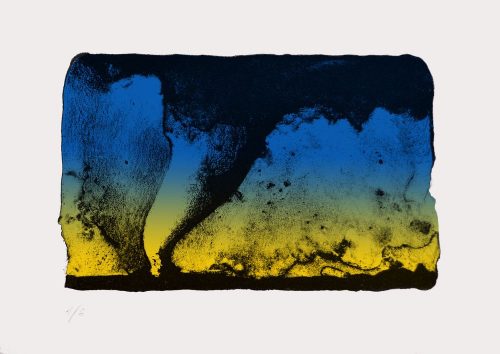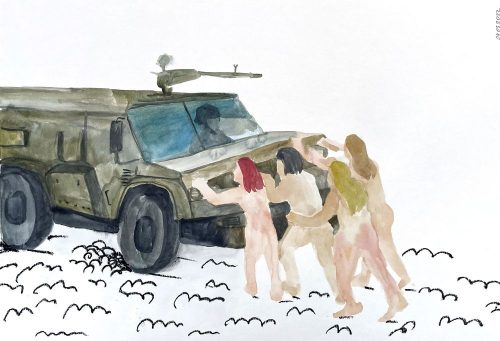Ukraine ablaze
The Ukraine Ablaze project is an art initiative to document and promote contemporary Ukrainian art, which traces the war in Ukraine from 2014 to the present moment of an ongoing full-scale Russian invasion in 2022.
The basis of the project is an online platform representing an archive of artistic statements, with profiles of artists and the possibility of public distribution of their works. Organising and taking part in actions and interventions in public spaces of various European cities is also an essential tool for us. These civic actions make the Ukrainian experience visible and create a network of solidarity, resistance, and support for all those who oppose Russian aggression.
Web-site Ukraine Ablaze
 Nina Savenko. The "Fire" artwork series
Nina Savenko. The "Fire" artwork series
 Yurii Ivantsyk. Untitled
Yurii Ivantsyk. Untitled
The project began in the first weeks of the full-scale invasion with an obsessive desire to collect everything that somehow reflects the events in Ukraine and allows spreading this experience among as many people as possible. We addressed this request to the cultural community, which shared its statements with us. Subsequently, the project gained a more focused framework by including in the archive the artworks created after 2014 (following the annexation of Crimea and the occupation of the Donetsk and Luhansk regions). The intention behind this was to emphasise the continuity of the war, transformation of artistic language, and actualisation of statements that are acquiring broader ways to be read in the new reality of wartime.
During the full-scale invasion, many artists deliberately abandoned their artistic practices and revised or transformed their languages. They are now resorting to collective work methods or carefully documenting the fragile reality around them. The archive allows us to reveal these transformations and experiences and see attempts to re-assemble the language and alterations in artistic expression. We acknowledge that the archive is a hierarchical structure because it has a subjective selection scale. Based on this, the archive can not be complete and comprehensive. There is an emptiness laid in its very existence and subjectivity. However, this feature also has a specific potential. It can make it possible to search for what is not included in the archive and why. Nevertheless, at the same time, the archive can become an origin for conversation and the development of shared knowledge, which expands its boundaries and frees from hierarchy through the diversity of views and interpretations of those who contemplate the archive.
 Alisa Gots. Stop War
Alisa Gots. Stop War
The title Ukraine Ablaze refers to the film-essay of the same name by Oleksandr Dovzhenko. This powerful image of Ukraine and its history is transgressive and recognisable. The burning tires of Maidan in 2014, the Volyn tragedy and the uprising of the Second World War, the revolutionary events of the national liberation struggle of 1917-1921 and many other intuitive chains produced by the collective unconscious immediately come to mind. An appeal to the image of fire can be seen in the works of artists who started creating them during the first weeks of the full-scale Russian invasion and generally since 2014. In these artworks, the fire was both a direct destructive symbol of burning and a symbol of steadfastness and readiness to fight. Despite the ambiguity of Dovzhenko's figure in Ukrainian history due to his relations with the Soviet authorities, his life path shows how personal choice "flirting" with ideology can "burn", i.e. deprive one of the privileges and lead to persecution. Coincidentally, what "burned" Dovzhenko was the film-essay "Ukraine Ablaze". This story once again reminds us of the impossibility of a neutral artistic expression and the author's figure out of context. On the other hand, the new connotations and realities that overgrow the metaphor of "Ukraine Ablaze" establish the potential for decolonial re-assembly of this image and figure of Dovzhenko. They also enable us to begin a painful conversation about our common past, from which it is impossible to turn away or close your eyes.
 Kinder Album. The "War Albumart" work series
Kinder Album. The "War Albumart" work series
From the long-term perspective, the project operates in three dimensions:
- An online platform consisting of collected works by the artists and their biographical information, commentaries, and contacts. This visual platform aims to function not only as an archive of statements but also to provide an opportunity for foreign colleagues worldwide to explore the various creative practices of Ukrainian artists and invite them to participate in their projects.
- Zine that aims to enrich the comprehension of the Ukrainian context through analytical articles on the use of Russian culture as a tool of propaganda, often latently; volunteer grassroots initiatives in Ukraine to support the cultural community and resolve humanitarian crises; personal war accounts by cultural workers.
- Public events and promotions. The artworks can be used at rallies around the world. Through public actions and a platform, the project helps to strengthen the support network between various foreign institutes and researchers interested in cooperation and support of the Ukrainian artistic environment.
We hope that through the artist statements, Ukraine Ablaze will have a therapeutic effect on the project’s participants and audience. And additionally, it will be able to symbolise the insightful dehumanised abyss in which we all find ourselves currently. The project engages independent researchers and cultural managers to support them, including financially. Now, the project operates on a volunteer basis and involves various cultural community representatives interested in further developing this project.
The project "Ukraine Ablaze" appeals to the world community not to remain silent! Together, we must find a new language for those who cry out in pain!
Our partners:
Web-site ukraineablaze.art development is funded by the International Relief Fund for Organisations in Culture and Education 2021 of the German Federal Foreign Office, the Goethe-Institut and other partners
Working on the project:
Nataliia Andreieva
Polina Baitsym
Valeriia Buradzhyieva
Andrii Myroshnychenko
Curator – Natasha Chychasova
If you have details to clarify, questions or suggestions for cooperation, send your request to the mail: [email protected]